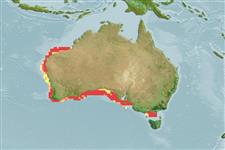Elasmobranchii (hajar och rockor) (sharks and rays) >
Rhinopristiformes (Shovelnose rays) >
Trygonorrhinidae (Banjo rays, Fiddler rays)
Etymology: Aptychotrema: Greek, a = without + Greek, ptyx, ptychos = fold + Greek, trema = hole (Ref. 45335).
Environment: milieu / climate zone / depth range / distribution range
Ekologi
marina bottenlevande; djupintervall ? - 125 m (Ref. 114953). Temperate; 19°S - 40°S, 112°E - 147°E (Ref. 114953)
Eastern Indian Ocean: endemic to western and southern Australia.
Size / Vikt / Age
Maturity: Lm ? range ? - ? cm
Max length : 84.0 cm TL hane/ej könsbestämd; (Ref. 114953)
Occurs near the shore and on the continental shelf from coastal fringe. Common on sandy beaches and seagrass beds (Ref. 006871, Ref. 114953). Mainly feeds on decapod crustaceans and small bony fishes. Females produces litters up to 16 pups. Maturity size for males at ca. 65 cm TL (Ref. 114953). Juveniles are caught with seines.
Life cycle and mating behavior
Könsmognad | Reproduktion | Lek | Ägg | Fecundity | Larver
Last, P.R. and J.D. Stevens, 1994. Sharks and rays of Australia. CSIRO, Australia. 513 p. (Ref. 6871)
IUCN Red List Status (Ref. 130435)
Threat to humans
Harmless
Human uses
Ytterligare information
Age/SizeTillväxtLength-weightLength-lengthLength-frequenciesMorfometriMorfologiLarverLarvdynamikRekryteringAbundansBRUVS
referenserVattenbrukVattenbruksprofilAvelslinjerGenetikElectrophoresesÄrftlighetSjukdomarBehandlingNutrientsMass conversion
MedarbetareBilderStamps, Coins Misc.LjudCiguateraHastighetSimsättGälytaOtolithsHjärnstorlekSyn
Verktyg
Special reports
Download XML
Internet-källor
Estimates based on models
Preferred temperature (Ref.
123201): 16.3 - 26.7, mean 18.3 °C (based on 218 cells).
Phylogenetic diversity index (Ref.
82804): PD
50 = 0.6250 [Uniqueness, from 0.5 = low to 2.0 = high].
Bayesian length-weight: a=0.00724 (0.00267 - 0.01964), b=3.00 (2.76 - 3.24), in cm total length, based on LWR estimates for this (Sub)family-body shape (Ref.
93245).
Trofisk nivå (Ref.
69278): 3.6 ±0.6 se; based on size and trophs of closest relatives
Resiliens (Ref.
120179): Låg, lägsta populationsfördubblingstid 4,5-14 år (Assuming fecundity<100).
Fishing Vulnerability (Ref.
59153): Moderate to high vulnerability (54 of 100).
